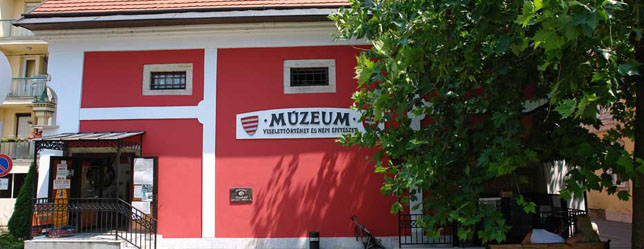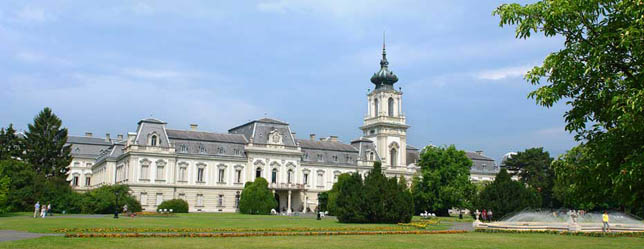
Trophy Exhibition
Members of the Festetics family had a reputation of trophy collectors – the western corridor of the castle was adorned with trophies, in the billiard room were antlers.
The West-Balaton area was always rich in wild game. And hunting was a favourite pastime of noblemen, aristocrats and politicians in every age.
The collection of the castle was destroyed after the Second World War. Only the antlers of a deer killed in 1883 in Somogy-county could be bought back – this piece is now on display in the exhibition. Among the 500 trophies can be found several world records.
Historical Model Railway Exhibition
The historical model railway is located in the attic of the new museum building next to the Festetics castle. The facility with its 508.6 square meter surface area, and a total of 2.5 kilometers of track is among the largest in Europe (next to Miniature Wonderland in Hamburg, and the Loxx miniature worlds in Berlin).
The trains rattle between mountains and hills, lakes and rivers and about 20 stations. The park is divided into three parts – all of them provide a section of the Southern Railways from the kuk Time up in the 60’s 70’s is of the past century – in Hungary, Austria and Germany. The detailed built locomotives (60-70 units) and the trains are controlled by three computers, and connected by a 30 km long cable network.
The beautifully designed facility – with real buildings from the different districts of Keszthely the Christmas market in Nuremberg, people waiting at the railway stations – leaves a deep impression.
Keszthely, as one of the Southern Railway Station is also shown here, along with the other stations.
The section in Germany with Nuremberg and Bad Schandau is located in the middle of the room. The Nuremberg train station with the 25 tracks is the largest station of the plant.
Pictures from exhibition
Map
Keszthely, Pál u.

CuriositiesIn the beautifully restored, close to 200 years old building we are informed not only about national costumes but dwelling houses featuring some areas as well. You can have a look at the model of famous Phoenix galleon of the Festetics. The original galleon was made in the workshop of an Italian shipbuilder from Bor in Fenékpuszta. The galleon was not made for romantic cruises but salt was carried with it which was the monopoly of the Festetics. Pannon Sea On the territory of Hungary, Pannon Sea was waving 15-20 million years ago. This was a unique so called inner sea separated from the ’world-sea’ by the range of the Alps and the Carpathian Mountains. Because of its special location a peculiar fauna and flora came into being. In its terrestrial deposit with unique of more than 1 m width this fauna and flora is seen still today.
The building of the Doll Museum used to be a granary, its caber main girber beams are 14 m long.
The tree which it was torn out from was planted during the time of Kossuth according to estimation at the time of Rákóczi War of Independence. At the building the stones of Roman fortress of Fenékpuszta were used as well- these parts were left in the original condition without any changes to make manifest.
The name itself Doll Museum is a bit misleading. Here not the dolls are important but the clothes they are putting on. The Doll Museum or The Museum of Costume History shows in a unique way the clothing of Hungary and the clothing of the Hungarian minorities living on the detached territories and its unbelievable diversity even in time and in space.
You can admire close to 500 gorgeous costumes of porcelain dolls It is curious to see the change of costume and with it the mentality featuring the territory e.g. by the ’Matyós’ clothes were considered to have been so important even in case of difficult living conditions.
As a matter of curiosity we have to mention that the costumes of Transylvania, of Northern Hungary, Sub Carpathian and of the south-land were made for the Museum with the help of applications. The dressmakers enclosed letter with the costumes as well. In these letters the difficulties of purchase process of the materials, names and ages of the old persons of the village were written and with the help of the letters the authenticity was proved. Lots of these letters are the gems of the archaic Hungarian language.
Snail Parliament Keszthely
Hearing the word ‘Snail Parliament’ we do not have to think of slowly working members of the parliament. In Keszthely this word has another meaning
The history of Snail Parliament
Ilonka Miskei built the maquette of Parliament in Budapest using 4,5 million houses of pannon sea snails since 1975, for 14 years. This Parliament is unique all around the world. She selected some million –year old fossils imitating the decoration of the house of Parliament.With this method the masterpiece was made and later she donated to The Museum of Costume History in 1999 after being stored in houses, stables and barns in Uny a small village in Komárom County.
Parliament- the pride of the country
The constructions of the original building, the Houses of Parliament started 15 October 1885 and in average 1000 people were working on it for 17 years. The designer, Imre Steindl was 44 years old at the beginning of the building later because of his illness close to the finishing he was able to direct the building only from a wheelchair. In 1902 he could not see the moving in because some weeks previously he died. The Parliament nowadays is the part of the world heritage.
Pictures from the museum
Map

Turning west on the one-time Italian military road leaving Kastély street –today it is Georgikon street- then after having passed 500 m, turning left at the traffic lights we get to the Georgikon building. Georgikon was the first agricultural higher education institution of Europe.
History of Georgikon
The Georgikon was found by Count György Festetics with Sámuel Tessedik’s cooperation in Keszthely in 1797.At the college besides theoretical studies there was practical education as well – the count created a model farm connected to Georgikon. Agronomists finishing the college were making good use of their knowledge in Festetics domain as leading functionaries.
The Georgikon left off in 1848 when the students took up military career in the war of independence.
In 1970 the building of Georgikon was converted into a hotel and the Manor Museum opened its gates in 1972.
Attractions in the museum
If we get a visit in the Georgikon Musem, we can enrich with much interesting information from those days when Hungary was considered to have been an agricultural great power. We can get to know what exec was, how grape was grown and how wines were produced in the surrounding of Balaton and the correct way of cereal storage.
We can be fully informed about the one-time manor farming, about the servants’ life next to the lord of manor and we can see a smithery and a cartwright’s workshop as well.
One of the most interesting exhibit articles is a steam-plough originates from the second half of the XIX century which was actively used with agricultural works in the 1860s in the last century. Today it is started only in case of bigger festivals; it is a big experience for olds and young people as well.
Pictures from the Museum
Map
Keszthely, Bercsényi utca 65-67.

The Balaton Museum Association was established in 1898 for among all Sándor Lovassy’s initiation. The starting of the museum building in Keszthely was in 1925 with the help of count Tasziló Festetics., on the basis of Györgyi Dénes’s designs in Neo-baroque style. With the building of the first museum of Zala county, the stones from pulled down stables next to Festetics Mansion were used as well.
The Collection of the Balaton museum

The collection shows the archaeological, ethnographical, historical and natural scientific values of Balaton area. During the World war II. the most valuable articles of collection were put in railway carriages to take them to safe place and to make them protected from bombardment. The train got bombarded at the railway station of Zalaegerszeg and its cargo was totally destroyed.
The Balaton Museum today
Today the Balaton Museum is waiting for renovation again. The stable exhibition showing the history of Balaton and its environment is the biggest exhibition is to be visited from September 2009.
Pictures from the Balaton Museum
Map
Keszthely
Múzeum u. 2.

This beautiful building in Baroque style is the third biggest castle of Hungary, Symbol of Keszthely.
History of Festetics Castle
Kristóf Festetics started to build the castle on the basis of Kristóf Hofstädter’s drawing who was the first master mason of the domain for three decades. The first big reconstruction was done in 1769 and it was Pál Festetics who had this work done. His son, György Festetics also had the castle reconstructed in 1792. Its present day appearance was given by II. Tasziló count between 1883 and 1887. In the reconstructed castle there were altogether 101 rooms which were needed to place countess Maria Hamilton Douglas’s train load quantity furnishings
The library room of Festetics castle
 The library room of Festetics Castle is the most commanding gallery found in the southern wing was finished by 1801. The library room is the treasury of encyclopaedias collected by the Festetics, engravings, belletristic literature from the enlightment period, technical books and scientific journals. The holdings of the library are preceding 90000 volumes- among them we can find more curiosities some of which pieces are well known all over the world.
The library room of Festetics Castle is the most commanding gallery found in the southern wing was finished by 1801. The library room is the treasury of encyclopaedias collected by the Festetics, engravings, belletristic literature from the enlightment period, technical books and scientific journals. The holdings of the library are preceding 90000 volumes- among them we can find more curiosities some of which pieces are well known all over the world.
Concert hall and park
The other beautiful gallery of the castle is the used to be dining room which is today the venue of famous concerts, opera concerts or not less famous weddings. As the marvellous castle park –or the amusement park – where walkers found good air and pleasant imperturbability in the end of XVIII century – it gives the same serenity for people today.
Exhibitions in the castle
The castle gives pace for more exhibitions. In the Coach Museum which used to be a coach garage and stable –watching the beautifully restored spider-carts, sledges, decorated coaches we have to wonder about what was meant that time on horsepower… One of the biggest , more than 500 m2 layout of Europe making heart throb for young and old as well is seen in the mansard of the new museum. The fans of padded animals can admire the trophy collection of Windischgrätz-, Széchenyi-and Kittenberger in a separate exhibition hall
Pictures from Festetics Palace
Map
Keszthely
Kastély utca 1.




































 The library room of Festetics Castle is the most commanding gallery found in the southern wing was finished by 1801. The library room is the treasury of encyclopaedias collected by the Festetics, engravings, belletristic literature from the enlightment period, technical books and scientific journals. The holdings of the library are preceding 90000 volumes- among them we can find more curiosities some of which pieces are well known all over the world.
The library room of Festetics Castle is the most commanding gallery found in the southern wing was finished by 1801. The library room is the treasury of encyclopaedias collected by the Festetics, engravings, belletristic literature from the enlightment period, technical books and scientific journals. The holdings of the library are preceding 90000 volumes- among them we can find more curiosities some of which pieces are well known all over the world.














